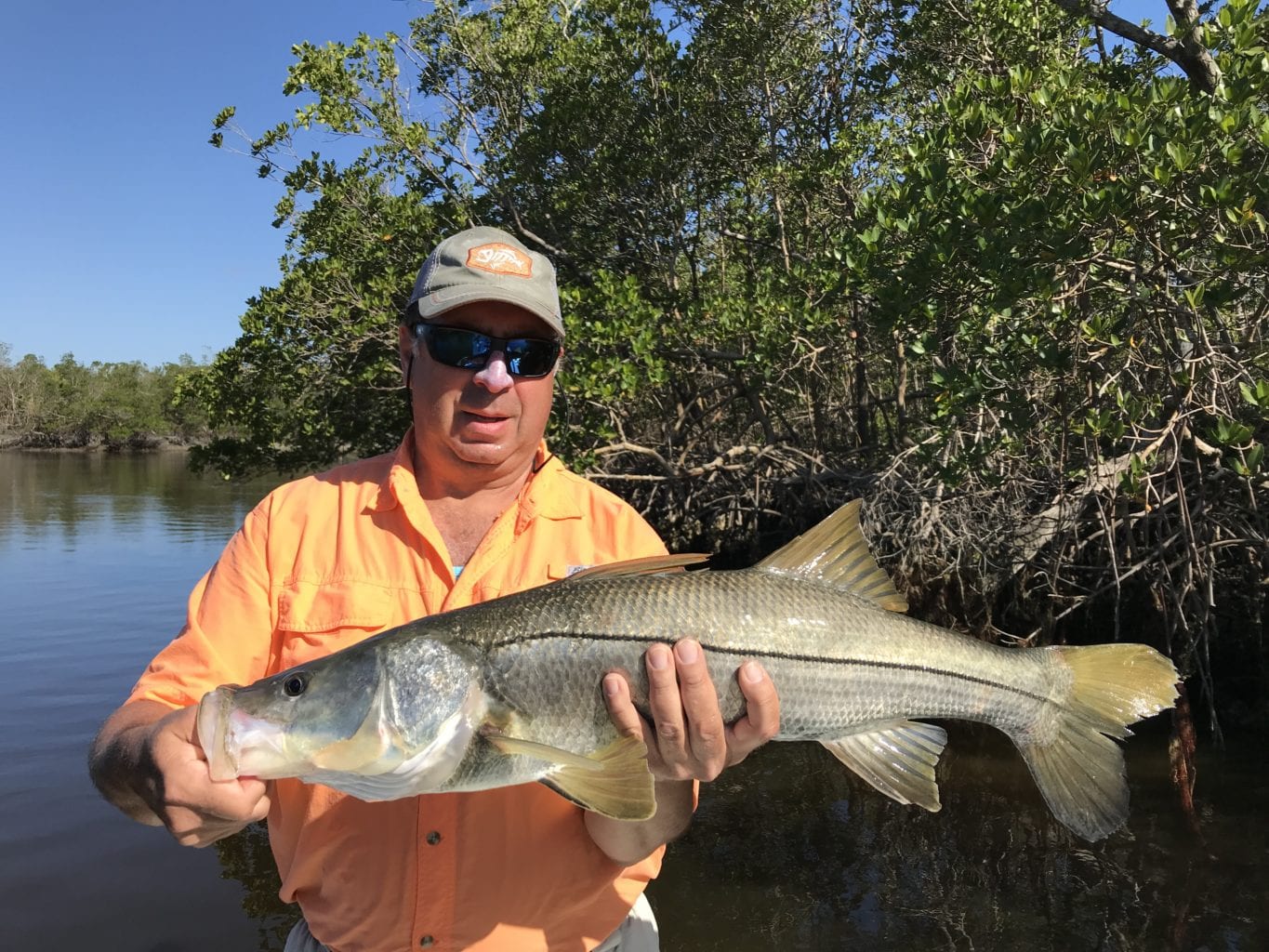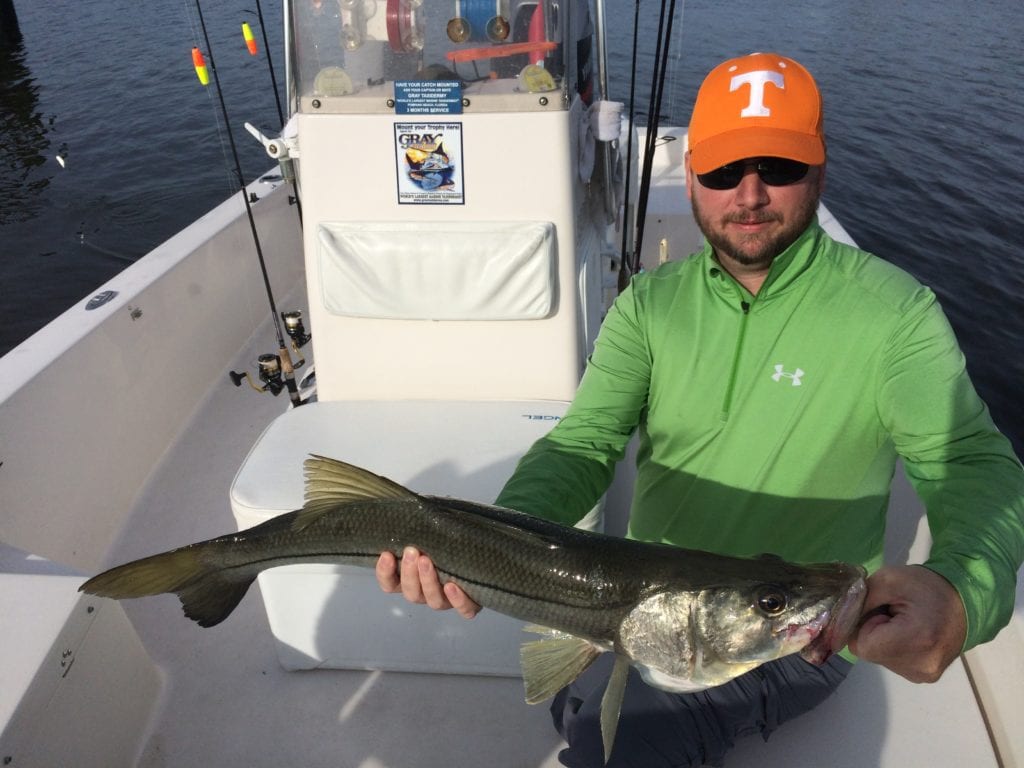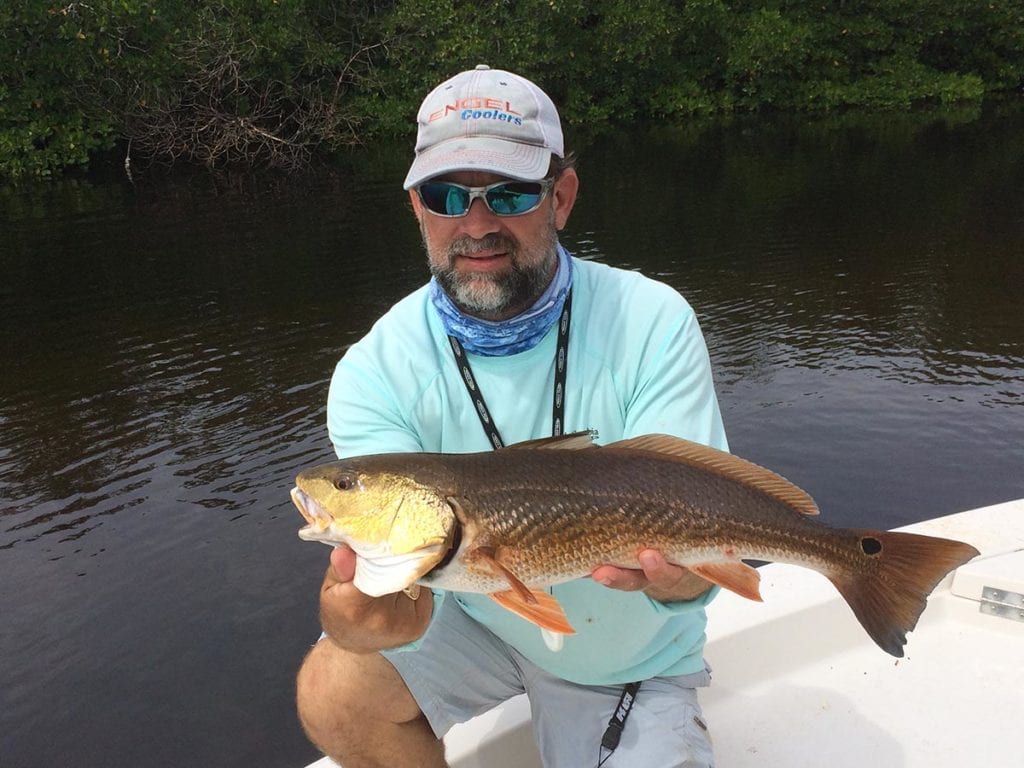
Winter in the Ten Thousand Islands does not mean ice or hibernation. It means wind-driven tides, water that cools into the sixties, and a network of mangrove estuaries alive with fish that move with every cold front. The region’s geography, stretching from Marco Island down through Chokoloskee, forms a vast transition between saltwater and freshwater. When the Gulf of Mexico cools, the labyrinth of creeks, bays, and rivers becomes a refuge for nearly every inshore species that calls this coast home.
The air feels mild compared to northern winters, yet the fish respond sharply to temperature drops. Each front rearranges their world. On the coldest mornings, the shallows empty, leaving mud flats and oyster bars high and dry. When the sun returns, that same exposed ground absorbs heat and draws life back toward it. The rhythm is simple but precise: cold sends fish deep, warmth calls them home.
How the Weather Shapes the Bite
The area’s winter pattern swings between fronts. After a front, a north or northeast wind strips water from the bays, dropping levels below prediction and chilling what remains. For the next day or two, fish hide in deeper channels, creeks, and bends. As the high pressure settles, the air clears, temperatures rise, and the sun begins to warm dark mud and oyster bottom. Two or three days into that pattern, feeding resumes. This cycle repeats through January and February.
For a fisherman, that means timing trips around the recovery window instead of the calendar date. Warm afternoons are prime time. The water temperature, not the season, dictates success. When it rises just a few degrees, baitfish appear on the surface again, birds gather, and predators wake up.
Species That Stay Active All Winter
Several species remain active through the winter months, each adapting in unique ways to cooler water and changing tides.
Snook in the Cold
Snook are sensitive to cold but not absent. They shift from the open bays into rivers and creeks where deeper water and dark bottom offer safety. Early in the day, they remain sluggish, holding tight to structure. By mid-afternoon, they rise toward the surface and hunt. Artificial lures that mimic shrimp or small baitfish work best when retrieved slowly along current seams. Live shrimp drifted near submerged roots often draw strikes when the fish seem unwilling to chase. Regulations keep harvest closed through the heart of winter, making this mostly a catch-and-release pursuit.
Redfish on the Flats
Redfish handle temperature swings more easily. Winter low tides expose the shallow flats they prefer, especially those lined with oysters or sand. Sight-casting becomes possible when the wind calms and the water clears. They feed on crustaceans that cling to exposed bottom, often crawling in just inches of water. Slow presentations and quiet movement make the difference between watching a wake slide away and watching a tail wave in front of you. One keeper per fisherman, with a strict vessel limit, keeps the stock stable through heavy pressure.
Seatrout and Sheepshead
Spotted seatrout school up in deeper holes after a front, sometimes gathering in numbers that seem endless. As soon as the temperature lifts, they fan out across the flats to feed. Light jigheads with small soft plastics or shrimp under a popping cork imitate the natural sound of feeding and trigger quick bites.
Sheepshead become dependable from late December through early spring. They pack onto oyster bars, mangrove roots, and bridge pilings. Small pieces of shrimp or fiddler crab are the most effective baits. Their cautious bite feels like a faint tap, requiring patience and finesse. Regulations protect them during the March and April spawn with a vessel limit meant to preserve breeding aggregations.
Pompano, Spanish Mackerel, and Tripletail
The outer passes hold pompano through much of winter. These fish prefer clean, moving water over sandy bottom. Metal jigs, such as the locally popular banana-style or “goofy” jig, hop across the sand and imitate small crabs and fleas. Spanish mackerel often roam the same areas, slashing through bait schools under diving birds. A wire leader prevents cut-offs, and quick retrieves keep lures clear of smaller bycatch.
Tripletail become a quiet prize of the cold months. From October through early May, they linger near crab trap buoys and channel markers. A well-placed cast to the shady side of a float with a shrimp under a cork can produce an immediate strike. Patience matters more than distance; most fish spook from noise before they refuse a bait.
Tarpon That Never Leave
Large migratory tarpon arrive later in spring, but juveniles stay in the backcountry all year. Warm spells bring them to the surface to roll in protected creeks. Light tackle or fly gear turns them into a realistic winter target, especially for those willing to fish the calmest hours of the day. Regulations require fish over forty inches to remain in the water, and nearly all tarpon encounters end with release.
Habitats That Hold Fish When It’s Cold
Every species finds comfort in a different corner of the islands. Oyster bars concentrate bait and provide ambush points for reds, trout, and sheepshead. Deep mangrove creeks become sanctuaries for snook. Outer passes connect the entire system to the Gulf and attract everything that hunts moving prey. The region’s mix of salinity, structure, and depth makes it stable even when fronts sweep across the state.
Knowing which zones stay warmest on a north wind is the real secret. Dark bottom and protected bends hold heat. Lee shores, where the sun strikes from morning through afternoon, often turn on hours before open water. Those same locations become dangerous to approach at negative low tides, so most experienced captains run shallow-draft skiffs and trim carefully to avoid grounding.
Reading the Water
Good winter fishermen study three variables each morning: wind, tide, and temperature. North or east winds can push water out faster than the tide predicts. The best move is to check NOAA or NWS marine data for both tides and wind strength. If a front has just passed, plan to fish deeper bends early, then move shallower as the sun builds. By afternoon, even a two-degree rise can ignite a bite on dark bottom flats. When the next front approaches, a few hours of low pressure may trigger another feeding window before the cycle resets.
Gear and Tactics That Work Best
A versatile inshore setup covers most species: a seven-foot medium spinning rod with ten-pound braid and a twenty-pound fluorocarbon leader. For heavier structure or small tarpon, step up to fifteen or twenty-pound braid and a thirty-pound leader. Jigheads from one-eighth to one-quarter ounce handle the slower winter presentations.
Key equipment considerations:
• Rod length and power suited to varied structure
• Line strength adapted for heavier cover or open water
• Proper leader weight for abrasion resistance
• Jig size adjusted to current and wind
• Realistic lures and natural baits matching forage
Soft plastics in natural or gold tones match the forage in cloudy water. Live shrimp remain the universal option when conditions are tough. For pompano, a bright metal jig hopped across sand stands out even in stained water. Tripletail respond best to accuracy rather than lure type, so approach quietly and place a shrimp exactly where shade meets sunlight.
Safety and Regulations in Practice
Large parts of this region fall within Everglades National Park and Ten Thousand Islands National Wildlife Refuge. Operating a motorboat in park waters requires completion of the free Everglades boater education course and possession of a park pass. Refuge waters follow normal state licensing. Collier County ramps charge day fees for launches and parking, typically ten dollars for a motorized vessel.
Important considerations for compliance and safety:
• Everglades boater education course required for motorboat use
• Park pass required within Everglades National Park
• County launch fees apply at all Collier facilities
• Seasonal manatee zones require slow-speed navigation
• Always confirm red tide or marine advisories before running offshore
Winter also coincides with manatee season. Slow-speed zones expand, and vigilance around creek mouths prevents collisions. Most zones are clearly posted, and maps are available from the Florida Fish and Wildlife Conservation Commission. Red tide occasionally drifts south into the area, so checking respiratory forecasts before planning offshore runs keeps trips safe and responsible.
Conservation and Handling in Cold Conditions
Cold water stresses fish more than most people realize. Snook in particular can suffer permanent damage if removed from the water during extreme cold. Handling them quickly and keeping their gills submerged increases survival. Tarpon require even more care; regulations prohibit lifting large fish entirely out of the water. Using heavier tackle for a faster fight and holding them upright until they swim off protects the population that makes this fishery world-class.
Sheepshead and snapper should be measured carefully before keeping. Small mistakes at the ruler can add up, and enforcement is consistent within both the refuge and the park. Carrying a bump board, a venting tool for deep fish, and a dehooker makes release work efficient and safe.
Planning a Full Winter Day
A typical winter day begins with deep water at first light, often around creek mouths or channels where the tide still covers structure.
General daily sequence:
- Start early in the deeper creeks and passes where water stays warmest.
- Move to sunlit, dark-bottom flats as temperatures rise.
- Target redfish and snook during the early afternoon feeding window.
- End the day with pompano in the passes or tripletail along buoy lines.
As temperatures climb, fishermen shift to the flats that face south or west, using the sun’s warmth to their advantage. Midday becomes prime for redfish and snook on those darker bottoms. Late afternoon offers a final window for pompano in the passes or tripletail on buoys before the next cool wind arrives.
Each day repeats this rhythm with small variations. Success depends more on reading the moment than on predicting the week. The Ten Thousand Islands reward attentiveness with constant change.
The Character of the Winter Fishery
Winter here feels quiet. Boat traffic thins, bait becomes scarcer, and the mangroves echo with birds rather than motors. Yet beneath that stillness, the ecosystem keeps working. Shrimp, crabs, and small mullet remain active enough to sustain predators. Fishermen willing to slow down and move with the tide find consistent action long after others hang up their rods. The system’s isolation and resilience make it one of the most reliable winter fisheries in Florida.
A Season Worth Exploring
The Ten Thousand Islands turn winter into a slower, more deliberate form of fishing. The cold brings clarity, forcing attention to detail and respect for timing. It is a season built on patience, not speed. When fished with understanding, it delivers days of calm water, quiet drifts, and steady hookups in one of the most complex coastal environments on the Gulf.
For anyone planning to explore these waters in the colder months, Chasin Tales Fishing Charters offers guided trips that track these seasonal movements daily. Every run into the islands adapts to the weather, tide, and pattern of the week, giving fishermen the advantage of experience and access to prime habitat. Join us for a day of winter fishing in the Ten Thousand Islands and see how alive this place remains when the rest of Florida slows down.



